Any coin in the Barber Series is bound to attract substantial attention in any auction. And even though it is not a key date of the series, the 1912 Barber Half Dollar is highly diversified with four varieties, each valuable enough to eclipse the $0.50 face value.
In this guide, we’ll discuss the varieties of this century-old coin and their respective value. We’ll also touch upon the history of the coin and the coin’s unique features. But before we delve into all that good stuff, here is an outline of the value of the 1912 Barber Half Dollar in different states of circulation.
| Coin Condition | Estimated Value | |||
| 1912-P Half Dollar | 1912-P Proof Half Dollar | 1912-D Half Dollar | 1912-S Half Dollar | |
| Circulated
(G4 – XF40) |
$24 – $225 | – | $23 – $225 | $24 – $285 |
| About Uncirculated (AU50 – AU58+) | $370 – $510 | $500 | $370 – $500 | $400 – $675 |
| Uncirculated
(MS60 – MS64+) |
$525 – $1,600 | $625 – $2,500 | $570 – $1,350 | $750 – $2,750 |
| Brilliant Uncirculated (MS65 or higher) | $2,250 – $23,000 | $2,850 – $15,750 | $2,000 – $6,500 | $3,750 – $13,000 |
1912 Half Dollar: Historical Background
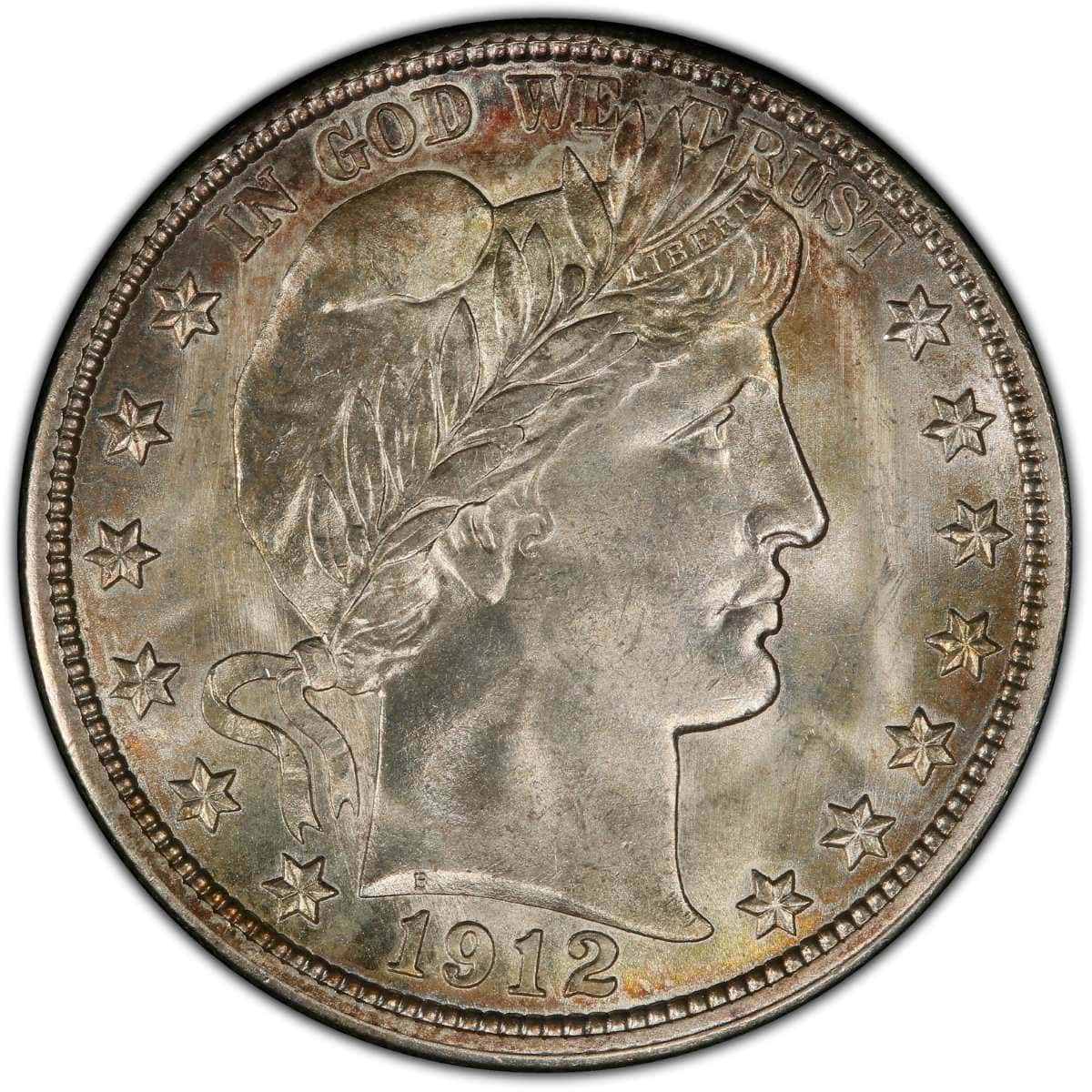
Let’s start with the big one: why is it called a Barber Half Dollar? The Barber coins are a series of U.S. coins that were designed by the legendary engraver Charles E. Barber. This series contains dimes, quarters, and half dollars that were minted from 1892 to 1916. A little side note here: no Barber Half Dollars were struck in that final year.
For inspiration, Charles Barber turned to French coinage. His obverse depicts Lady Liberty wearing a Phrygian cap, an idea that had been heavily explored among the 20 Franc Gold Mariannes of the time.
Physical Features of the 1912 Half Dollar
If you Google the image of a 1912 Barber Half Dollar, you’ll find a bunch of coins with some interestingly-colored patinas. The natural color of the 1912 Half Dollar is silver. A patina is the result of oxidation on the metals that make the 1912 Barber Half Dollar.
Speaking of metallic composition, the 1912 Half Dollar is made of one part copper and nine parts silver, a trend that was killed by the passing of the Coinage Act of 1965.
Another note-worthy property of the 1912 Barber Half Dollar is its 30mm diameter. For some perspective, that’s just 6mm narrower than today’s Kennedy Half Dollar. As for the edge, the 1912 Half Dollar is decorated with vertical reeds, adding to the beauty and texture of the coin.
Obverse Design and Features

We cannot talk about the physical attributes of a coin without discussing its faces. As you already know, both faces of the 1912 Barber Half Dollar were designed and executed by Charles E. Barber. What we didn’t mention was the design elements Barber used on his coins and their location on the coin.
Perhaps the table below will clear things up. It shows each character that Barber used on the obverse and its location on the coin.
| Character | Location |
| Lady Liberty | Coin’s center |
| The inscription “LIBERTY” | On Lady Liberty’s head |
| The legend “IN GOD WE TRUST” | Along the top rim |
| 13 Stars | Six stars along the left rim
Seven Stars along the right rim |
| Date “1912” | Along the lower rim |
| Monogram of Barber’s initials | On the cutoff of Lady Liberty’s neck |
Reverse Design and Features

The reverse of the 1912 Half Dollar was also the brainchild of Charles E. Barber. Barber carried a lot of elements from the previous Seated Liberty Half Dollar, including the bald eagle, the shield, the arrows, and the olive sprig.
The table below highlights these characters and their location on the reverse of the 1912 Barber Half Dollar:
| Character | Location |
| A bald eagle with stretch-out feet and wings | At the center |
| A shield | On the eagle’s breast |
| The banner “E PLURIBUS UNUM” | Between the beaks of the eagle |
| 13 Stars | Over the eagle’s head |
| An olive sprig with 13 leaves | Clasped between the left talons |
| 13 arrows | Clasped between the right talons |
| “UNITED STATES OF AMERICA” | Along the upper rim |
| “HALF DOLLAR” | Along the lower rim |
| Mint mark (D, S, or None) | Under the eagle’s tail |
1912 Half Dollar: Mint Mark and Varieties
One of the quickest ways to identify the varieties of a coin is by studying its mint marks. And along these lines, the 1912 Half Dollar has three varieties. But because the Philadelphia facility struck both regular and proof coins, we can add proof coins to our list of varieties.
1912-P Half Dollar Value
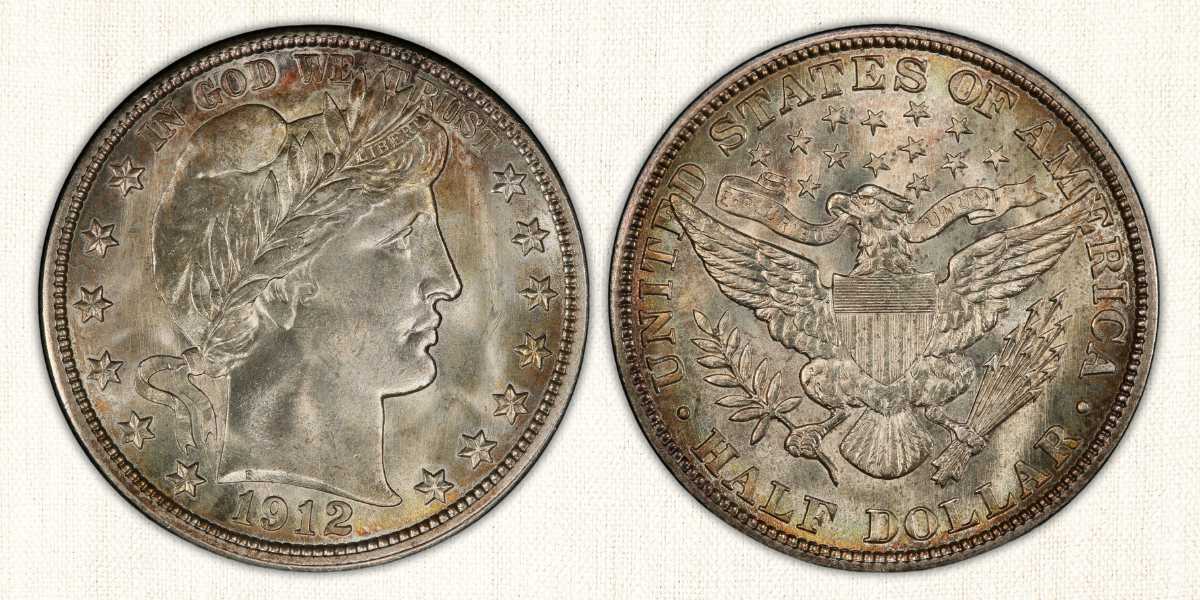
- U.S. Mint: Philadelphia
- Mintage: 1,550,000
- Mint Mark: None
The 1912-P Half Dollar is attainable in all grades until MS66. I’m using the word “Attainable” loosely to mean that if you’re willing to pay for it, you can come into possession of a 1912-P Barber Half Dollar. But in no way is this coin cheap.
Even in heavily circulated conditions, the 1912-P Half Dollar commands values that range between $24 and $225. And these prices will continue to rise. According to our own market research and general price trends, the value of the circulated 1912-P Half Dollars has shown a steady uptick in the last decade.
The value of About Uncirculated 1912-P Half Dollars peaked between 2014 and 2015. Since then, these coins have failed to recapture their former glory. Today, About Uncirculated 1912-P Barber Half Dollars are worth between $370 in MS50 condition and $510 in MS58.
Among the uncirculated lot, price trends have been a choppy affair. MS65 and MS66 examples are trending downwards. Today, these coins are worth $2,250 in the MS65 state and $10,000 in the MS66 condition. MS66+ examples exist, and they are worth $23,000.
| Coin Condition | Estimated Value |
| Good (G4) | $24 |
| Very Good (VG8) | $30 |
| Fine (F12) | $70 |
| Very Fine (VF20) | $115 |
| Extremely Fine (XF40) | $225 |
| About Uncirculated (AU50) | $370 |
| About Uncirculated (AU58) | $510 |
| Uncirculated (MS60) | $525 |
| Brilliant Uncirculated (MS65) | $2,250 |
| Brilliant Uncirculated (MS66) | $10,000 |
An MS66+ Half Dollar was auctioned off in 2010 by Heritage Auctions for $23,000. The coin once belonged to the Dukor Collection and sported a rose gold patina. Below is a video showcasing the coin:
A slightly inferior MS66 example was sold in 2015 for $15,000. Remember, 2014 and 2015 were when the prices of these coins peaked. Today, it may be difficult to realize these figures. So, if you’re looking to buy or sell, use our price estimates in the table above as a guide.
1912-D Half Dollar Value
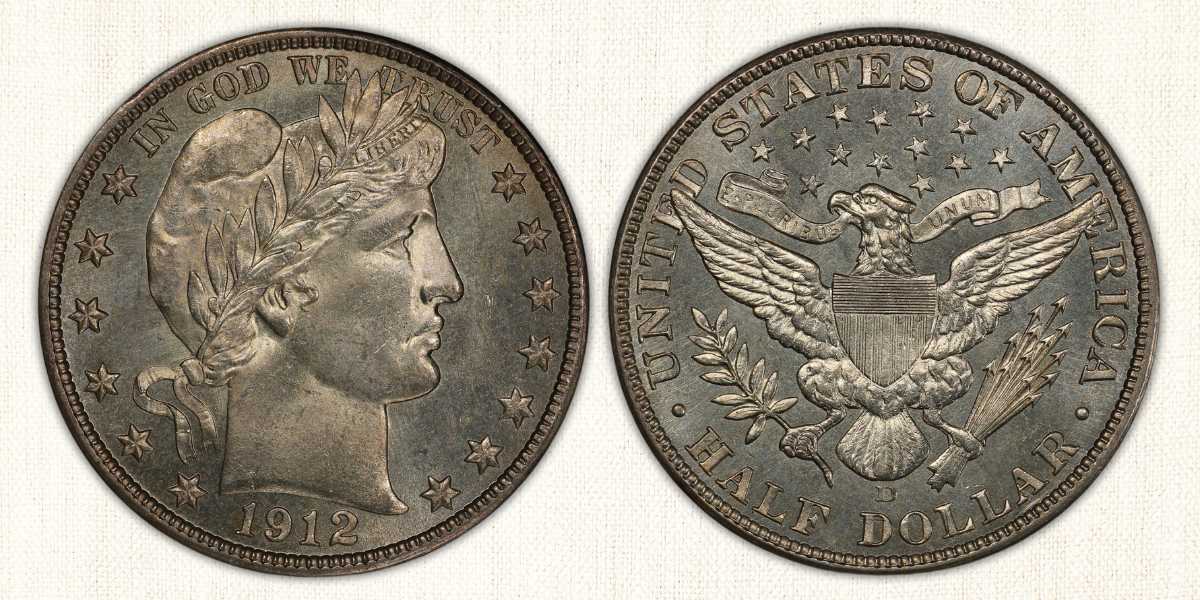
- U.S. Mint: Denver
- Mintage: 2,300,800
- Mint Mark: D
The Denver Mint bested its Philly counterpart in mintage. This is perhaps the reason why the 1912-D Half Dollar is the most common variety in the coin family.
In circulated condition, a 1912-D Barber Half Dollar can cost you between $23 and $500, depending on its condition. On the open market, uncirculated examples have sold for more. An AU58 example sold in 2021 for $575.
On the higher end of the Sheldon Scale, 1912-D Half Dollars are worth between $570 for an MS60 example and $6,500 for an MS66+. PCGS has graded a finer example in MS67. This 1912-D Half Dollar sold on Legend RC for 18,212.50.
| Coin Condition | Estimated Value |
| Good (G4) | $23 |
| Very Good (VG8) | $28 |
| Fine (F12) | $80 |
| Very Fine (VF20) | $115 |
| Extremely Fine (XF40) | $225 |
| About Uncirculated (AU50) | $370 |
| About Uncirculated (AU58) | $475 |
| Uncirculated (MS60) | $570 |
| Brilliant Uncirculated (MS65) | $2,000 |
| Brilliant Uncirculated (MS66) | $4,000 |
| Brilliant Uncirculated (MS66+) | $6,500 |
1912-S Half Dollar Value

- U.S. Mint: San Francisco
- Mintage: 1,370,000
- Mint Mark: S
The 1912-S Half Dollar is relatively common in the low grades. Its population then picks up at MS61 through MS64. 1912-S Barber Half Dollars in circulated condition are worth between $24 and $675.
Uncirculated 1912-S Half dollars can fetch up to $13,000 in MS67 condition. Examples in MS65, MS66, and MS67 are quite rare, and that’s why they flaunt values that range from $3,750 to $13,000. Examples with grades of MS60 to MS64+ have values that range from $750 and $2,750.
Below is an outline of the value of these coins.
| Coin Condition | Estimated Value |
| Good (G4) | $24 |
| Very Good (VG8) | $28 |
| Fine (F12) | $70 |
| Very Fine (VF20) | $135 |
| Extremely Fine (XF40) | $285 |
| About Uncirculated (AU50) | $400 |
| About Uncirculated (AU58) | $615 |
| Uncirculated (MS60) | $750 |
| Brilliant Uncirculated (MS65) | $3,750 |
| Brilliant Uncirculated (MS67) | $13,000 |
On the open market, there are exceptional coins that have sold for way more, like this 1912-S Half Dollar that sold on Bowers & Merena for $16,500.
A price tag of $16,500 is still high even by 1997 standards. Below is a list of other notable sales of the 1912-S Half Dollar:
| Grade | Sales Price | Auction Firm |
| MS67 | $12,650 | Heritage Auctions |
| MS67 | $11,500 | Heritage Auctions |
| MS67 | $10,925 | Heritage Auctions |
| MS67 | $9,987 | Heritage Auctions |
1912-P Proof Half Dollar Value

- U.S. Mint: Philadelphia
- Mintage: 700
- Mint Mark: None
This is by far the most rare variety of the 1912 Half Dollar. Only 700 of these coins were struck, and not all of them survived.
Proof, as well as Proof Cameo sub-varieties, are available. The 1912-P Proof coins are available from AU58 up to PR68. These coins are worth between $500 and $15,750.
Proof Cameo 1912-P Half Dollars are available in PR64 condition up to PR67. In these conditions, the 1912-P Proof Cameo Half Dollars are worth between $2,300 and $13,500.
| Coin Condition | Estimated Value | |
| Proof | Proof Cameo | |
| About Uncirculated (AU58) | $500 | – |
| Uncirculated (PR60) | $625 | – |
| Uncirculated (PR61) | $725 | – |
| Uncirculated (PR62) | $975 | – |
| Uncirculated (PR63) | $1,100 | – |
| Uncirculated (PR64) | $1,600 | $2,300 |
| Uncirculated (PR65) | $2,850 | $4,250 |
| Uncirculated (PR66) | $4,200 | $6,600 |
| Uncirculated (PR67) | $7,000 | $13,500 |
| Uncirculated (PR68) | $15,750 | – |
The most expensive 1912 Barber Half Dollar ever sold is a proof coin. This 1912-P Proof Half Dollar was sold in 2005 for $51,750 in an auction organized by Heritage Auctions. The Barber Half Dollar was graded PR68CAM.
Another 1912-P Proof Half Dollar that fetched a high price was sold at Stack’s Bowers in 2011. Another 1912-P Proof Half Dollar that fetched a high price was sold at Stack’s Bowers in 2011. With a grade of PR67, this gem is painted in a beautiful rainbow patina. This coin sold for $25,875.
1912 Half Dollar Error Coins
The 1912 Barber Half Dollar is not exactly famous for its error coins. The coin was fairly well-struck, and it’s difficult to find any error coins. Below are some errors that you may encounter:
1912 Half Dollar Struck on 1902 Half Dollar
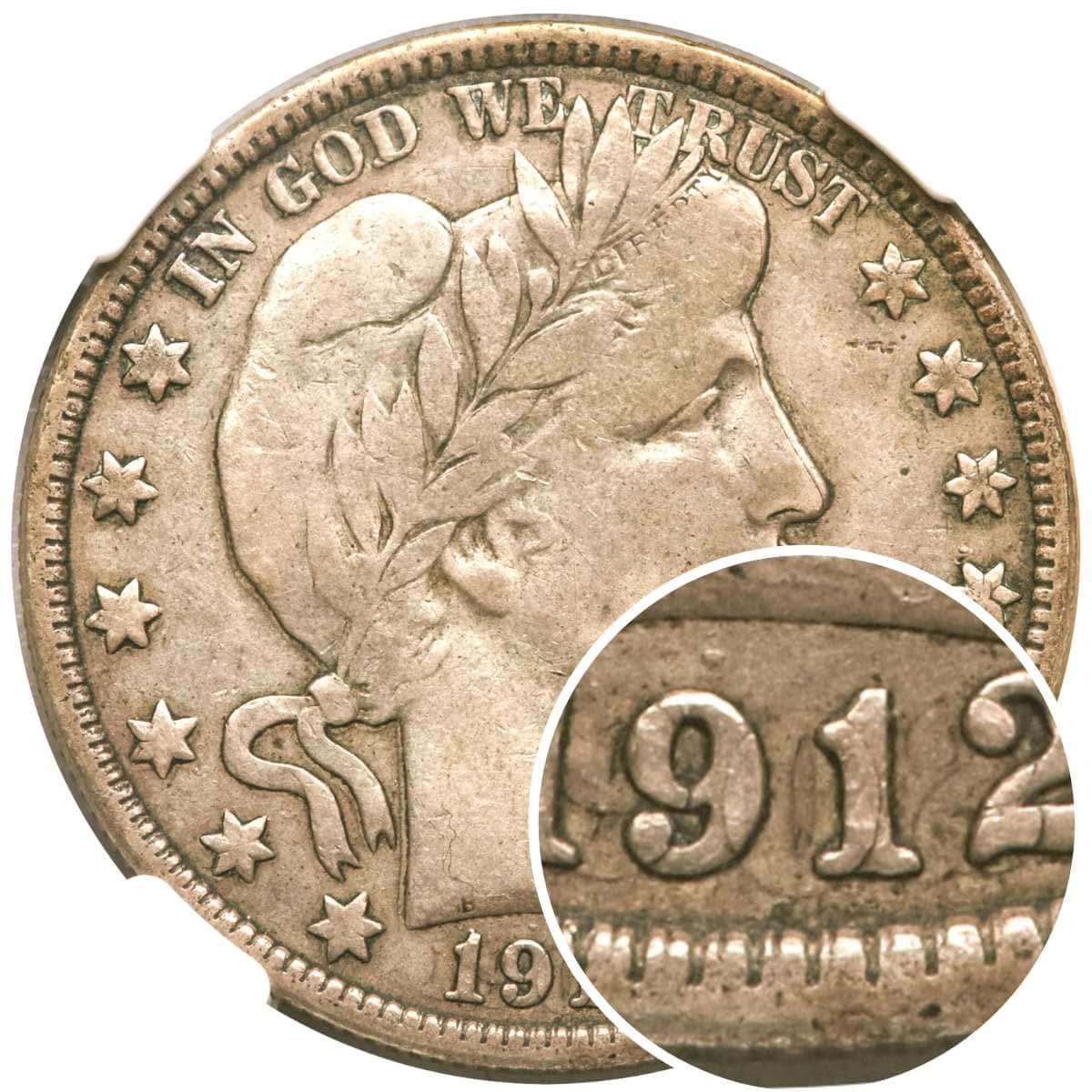
The idea of using old coins to make new ones is not alien to the U.S. Mint. What they would do is restrike old coins with their latest die. In this example, they took 1902 Half Dollar coins and struck the 1912 design on the then-decade-old coin.
There’s a 1912-D Half Dollar on Heritage Auctions with this exact error. If you study the date “1912,” you’ll see a faint outline of the date 1902; consider the image below.
From the image above, it appears the two dates are out of sync. The “1902” date seems to be shifted to the left. There’s no other known coin with this error. This 1912-D Half Dollar is reserved on the Heritage Auctions for $7,500.
Rainbow Toning
While it is not an error, rainbow toning on 1912 Half Dollars is very common. It is caused by the oxidation of silver, giving the coin a wash of rainbow colors. A rainbow toning does not affect the value of the coin; however, there are collectors who prefer coins covered in rainbow colors.
This obsession has led to the rise of artificial coin toning. Coin Value List, among other coin grading services, does not grade artificially toned coins. It goes without mentioning that you should exercise caution when buying coins with artificial rainbow toning.
Final Thoughts
The 1912 Barber Half Dollar is not a beginner-friendly coin. The coin is fairly expensive, even in low grades. This is a coin that is suitable for the experienced collector who has a war chest worth between a few hundred and a couple thousand dollars.
The 1912 Half Dollar is rich in varieties, and tracking all of them down will take time and money. If you’re up for a challenge, the 1912 Barber Half Dollar could just be the coin for you.
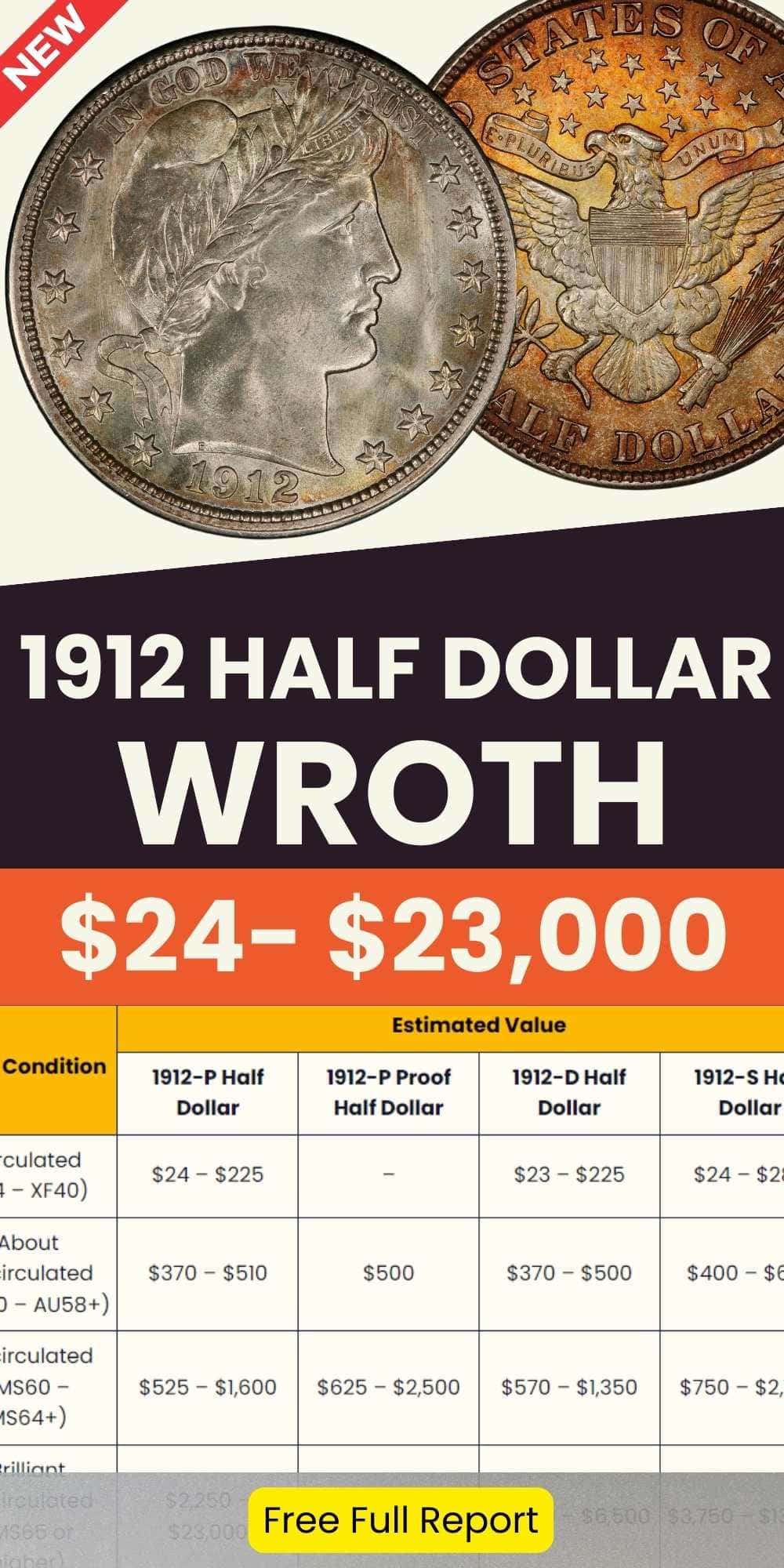
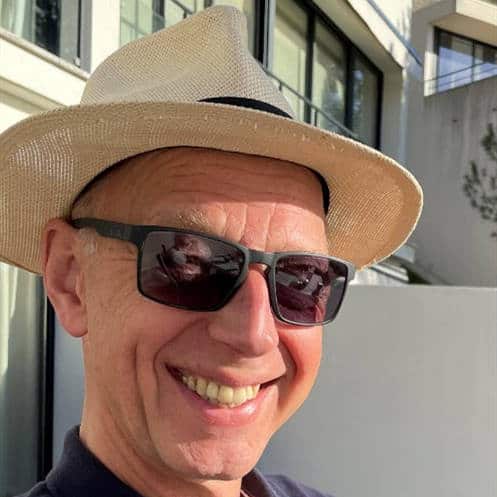
Jenson is a professional numismatist, a dedicated coin collector, a graduate of the College of Business at Oregon State, a life member of the American Numismatic Association (ANA), and an overall coin nerd. He is the founder of Coin Value List.
